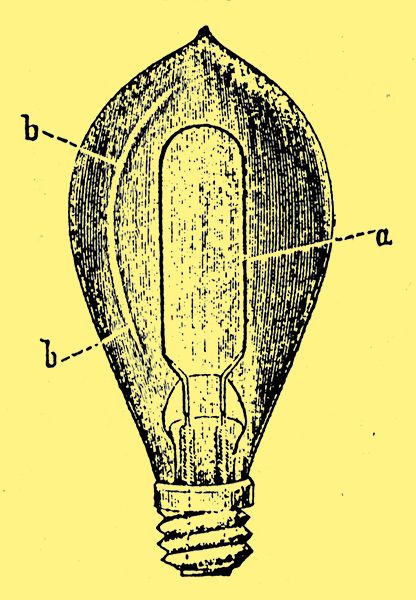|

Glow-lamp, having the glass bulb blackened by deposit of carbon, showing the molecular scattering which has taken place from the point a on the filament, and the shadow or line of no deposit produced at b.
Based on a diagram taken from Proceedings of the Royal Institution, February 14, 1890, which illustrated a paper by Prof. J A Fleming, Problems in the Physics of an Electric Lamp.
Supporters of Thomas A Edison would certainly claim that 1983 is the true centenary of electronics as a technology. It was a hundred years ago that this prolific inventor discovered 'the Edison Effect', later to be known as thermionic emission. He had discovered that the discolouration of the inside of a carbon-filament electric light bulb was reduced in the plane of the filament, but only on one side of the bulb, and that on the side of the filament which was connected to the positive pole of the supply. He reasoned that the positive half of the U-shaped filament was casting a 'shadow' between the negative half and the glass. Later, he found that if he put a tinfoil coating on part of the inside of the evacuated glass bulb, a current could be made to flow across the empty space between the hot filament and the tinfoil coating. He noted the fact later to have such practical importance that this current would flow in one direction only.
But although the electron had been postulated (as the minimum amount of charge carried by an ion) and named as such by Johnstone Stoney in 1874, the idea of this particle of negative electric charge moving about and constituting an electric current was not yet known to the practical experimenters of the 1880s. So it did not occur to Edison that the one-way current he had observed was in fact the result of any such entities travelling through the empty space in his lamp. It was a great mystery to him and the Edison Effect remained a scientific curiosity for a while.
A decade or more had to pass before J J Thomson found that it was possible to validate the existence of the electron by measurement. He measured the charge/mass ratio of the electrons constituting the cathode rays that had been investigated by William Crookes and others in the 1870s. From this work arose, about 1897, the Thomson concept of the atom as a positively charged mass with a lot of small negatively charged electrons embedded in it, sufficient for the atom as a whole to have no net charge. Thomson also studied the Edison Effect at about this time and established that the current flowing through the empty space was in fact a stream of electrons.
In the present story the old saw that the British make discoveries and inventions which the Americans then turn into successful products is manifestly the inverse of the truth. It was J A Fleming who not only experimented with the Edison Effect but showed an awareness of its practical possibilities when he wrote to Guglielo Marconi: 'I have not mentioned this to anyone yet as it may become very useful'.
Flemings crucial work resulting in the invention of the thermionic diode as a practical device for use in wireless telegraphy was not done until 1904. Is this, then, the true date of birth of electronics technology? The retrospective account which Fleming gave in his book 'Fifty Years of Electricity' (published by Wireless World in the 1920s) may help one to think about it. He recalls:
'The author had carefully studied in 1883 and 1896 . . . the so-called Edison effect in glow lamps discovered by Edison in 1883, and by 1904, as a consequence of the researches of Sir J J Thomson, it was well known that an incandescent filament of carbon in a high vacuum was giving off torrents of electrons or particles of negative electricity. Also, it had been found by the author that the space in a high vacuum between an incandescent cathode and a cold anode could conduct negative electricity from the hot to the cold electrode, but not in the reverse direction. It was not at all obvious, however, that a carbon filament incandescent lamp with a plate sealed into the bulb could be used to rectify high-frequency alternating currents; that is, to convert them into continuous or direct currents. Mr Edison had made no such use of his Edison effect lamps, nor had it occurred to anyone, until the author pointed it out, that such a lamp, having a metal cylinder surrounding the filament and carried on a wire sealed through the bulb, could be used to rectify high frequency currents and, therefore, as a detector of electric waves in wireless telegraphy'.
'The author, however, constructed in 1904 some carbon filament incandescent lamps in which the filament was surrounded by a metal cylinder carried on a platinum wire sealed through the bulb. These lamps had their filaments made incandescent by a six-cell storage battery, and they were connected . . . with the receiving circuit of a wireless telegraph apparatus . . .'
'It was at once found that this thermionic valve gave us a very simple, easily managed detector of electric waves in radio-telegraphy'.
All praise to Fleming for inventing the thermionic diode from which, of course came Lee de Forests triode, modern radio technology and eventually electronics. (The triode oscillator was used in an early electronic instrument for measuring mechanical displacement by capacitance variation only a few years after the invention of this type of valve. But whether Fleming in 1904 or Edison in 1883 was the true founder of electronics as a technology will probably remain a matter for historical interpretation.
|